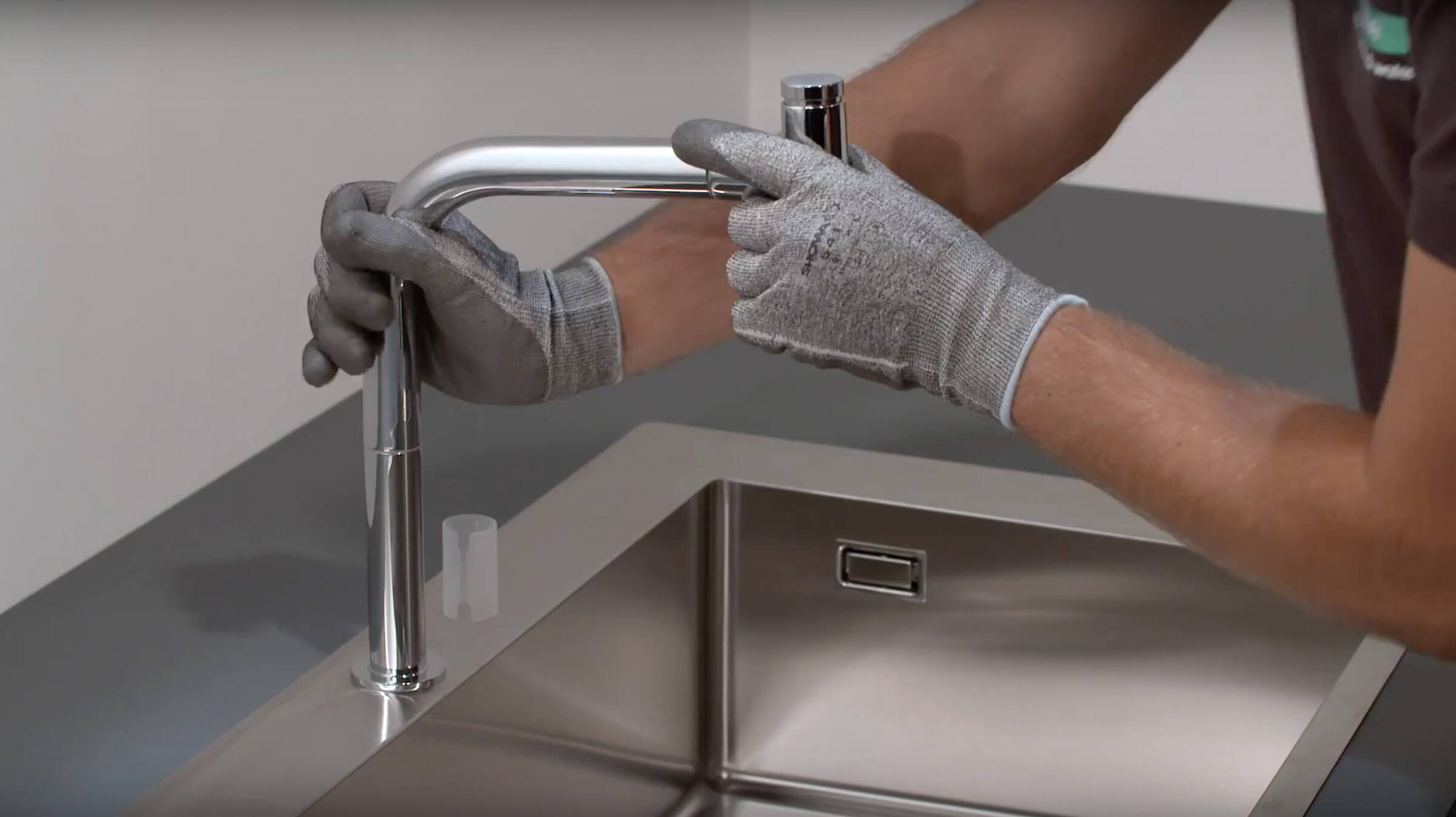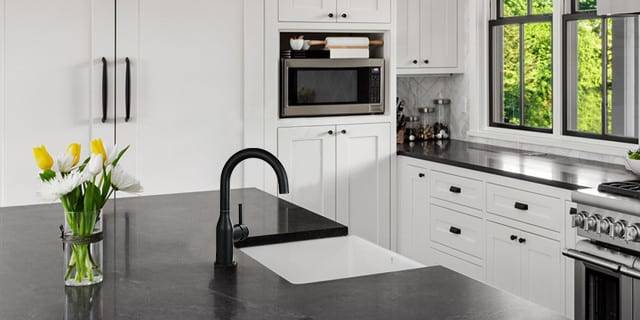Many people often wonder if it is possible to use a kitchen faucet for a bathroom sink. The answer is yes, it is definitely possible. In fact, kitchen faucets can offer many benefits when used in a bathroom sink. Let's explore the reasons why and how you can make this switch in your own bathroom.1. Yes, kitchen faucets can be used for bathroom sinks
Before we dive into the advantages of using a kitchen faucet in a bathroom sink, let's first understand the key differences between these two types of faucets. Kitchen faucets are designed to withstand heavy usage, such as washing dishes and filling large pots, while bathroom faucets are primarily used for tasks like washing hands and brushing teeth. This means that kitchen faucets are typically larger and have a higher flow rate compared to bathroom faucets.2. Differences between kitchen and bathroom faucets
If you have decided to use a kitchen faucet in your bathroom sink, the first step is to ensure that the faucet will fit. Measure the distance between the holes in your sink, as kitchen faucets usually require more space. If the measurements match, you can proceed with installation. Follow the manufacturer's instructions carefully and make sure to use the proper tools. If you are not comfortable with DIY projects, it is best to hire a professional plumber.3. How to install a kitchen faucet on a bathroom sink
One of the main benefits of using a kitchen faucet in a bathroom sink is the higher flow rate. This means that you will have a stronger and more efficient water stream for tasks such as washing your face or filling up a bucket for cleaning. Additionally, kitchen faucets often have a longer reach, making it easier to wash your hands without bumping against the sink. They also come in a variety of styles and finishes, giving you more options to match your bathroom decor.4. Benefits of using a kitchen faucet in a bathroom sink
When choosing a kitchen faucet for your bathroom sink, it is important to consider the style, size, and functionality. Some popular options include pull-down or pull-out faucets, which offer flexibility and convenience, and touchless faucets, which are more hygienic and easy to use. Make sure to also check the flow rate and choose a faucet with a lower GPM (gallons per minute) for water conservation.5. Best kitchen faucets for bathroom sinks
Choosing the right kitchen faucet for a bathroom sink can be overwhelming with the many options available. To make the process easier, consider the style and finish of your bathroom, the size of your sink, and your budget. It is also important to check the warranty and customer reviews to ensure that you are getting a high-quality and durable faucet.6. How to choose the right kitchen faucet for a bathroom sink
On the other hand, some people may wonder if it is possible to use a bathroom faucet in a kitchen sink. While it is technically possible, it is not recommended. Bathroom faucets are not designed to withstand the heavy usage and high flow rate of a kitchen sink, and they may not have the same features and functionality as a kitchen faucet.7. Can a bathroom faucet be used in a kitchen sink?
As with any decision, there are pros and cons to using a kitchen faucet in a bathroom sink. The main advantages have already been discussed, including a higher flow rate and more options for styles and finishes. However, there are some potential downsides as well. Kitchen faucets may be more expensive than bathroom faucets, and they may require more maintenance and cleaning due to their larger size.8. Pros and cons of using a kitchen faucet in a bathroom sink
If you already have a kitchen faucet that you would like to use in your bathroom sink, you can easily convert it by replacing the aerator. The aerator is the small piece at the end of the faucet that controls the water flow. Bathroom aerators typically have a lower flow rate than kitchen aerators, so by switching them out, you can decrease the flow rate of your kitchen faucet to make it more suitable for a bathroom sink.9. How to convert a kitchen faucet for use in a bathroom sink
There are a few misconceptions about using kitchen faucets in bathroom sinks that may discourage people from making this switch. One of the most common is that kitchen faucets are more difficult to clean. While they may have more surface area, they can be cleaned just as easily as bathroom faucets with the right tools and techniques. Another misconception is that kitchen faucets are too big for a bathroom sink. While some may be larger, there are also many smaller options available that can fit perfectly in a bathroom sink. In conclusion, using a kitchen faucet in a bathroom sink is not only possible but also offers many benefits. From a stronger water flow to a variety of styles and finishes, it can be a great choice for those looking to upgrade their bathroom. Just make sure to choose the right faucet for your needs and follow proper installation instructions to enjoy all the advantages of this switch.10. Common misconceptions about using kitchen faucets in bathroom sinks
The Versatility of Kitchen Faucets: Aesthetic and Functional Addition to Your Bathroom

The Evolution of Faucets
 The kitchen and bathroom are two of the most important areas in a house when it comes to design and functionality. These spaces not only serve practical purposes but also reflect the style and personality of the homeowners. And when it comes to design, even the smallest details matter. This is where kitchen faucets come in.
Traditionally, kitchen faucets were designed solely for the kitchen sink. However, with the constant evolution of interior design, these fixtures have become more versatile and can now be used in other areas of the house, including the bathroom sink.
The kitchen and bathroom are two of the most important areas in a house when it comes to design and functionality. These spaces not only serve practical purposes but also reflect the style and personality of the homeowners. And when it comes to design, even the smallest details matter. This is where kitchen faucets come in.
Traditionally, kitchen faucets were designed solely for the kitchen sink. However, with the constant evolution of interior design, these fixtures have become more versatile and can now be used in other areas of the house, including the bathroom sink.
The Benefits of Using Kitchen Faucets in the Bathroom
 Kitchen faucets
are not only limited to the kitchen, they have also become a popular choice for bathroom sinks due to their aesthetic and functional features. One of the main benefits of using a kitchen faucet in the bathroom is the wide range of styles and finishes available. From modern and sleek to traditional and elegant, there is a kitchen faucet design that can complement any bathroom design theme.
In addition to their aesthetic appeal, kitchen faucets also offer practical advantages when used in the bathroom. Most kitchen faucets come with a pull-down or pull-out sprayer, making it easier to wash your face or hair in the sink. This feature is especially helpful for those with limited mobility or for parents who need to assist their children in their daily grooming routine.
Kitchen faucets
are not only limited to the kitchen, they have also become a popular choice for bathroom sinks due to their aesthetic and functional features. One of the main benefits of using a kitchen faucet in the bathroom is the wide range of styles and finishes available. From modern and sleek to traditional and elegant, there is a kitchen faucet design that can complement any bathroom design theme.
In addition to their aesthetic appeal, kitchen faucets also offer practical advantages when used in the bathroom. Most kitchen faucets come with a pull-down or pull-out sprayer, making it easier to wash your face or hair in the sink. This feature is especially helpful for those with limited mobility or for parents who need to assist their children in their daily grooming routine.
Things to Consider When Choosing a Kitchen Faucet for Your Bathroom
 When considering using a kitchen faucet in your bathroom, there are a few things to keep in mind. First, make sure the faucet is compatible with your bathroom sink and plumbing. It is also important to consider the size and height of the faucet, as well as the reach of the spout, to ensure it fits your bathroom sink and provides enough space for hand washing.
Additionally, be sure to choose a kitchen faucet with a finish that complements your bathroom's overall design. Popular finishes for kitchen faucets include chrome, brushed nickel, and bronze. These finishes not only add a touch of style to your bathroom, but they are also easy to clean and maintain.
When considering using a kitchen faucet in your bathroom, there are a few things to keep in mind. First, make sure the faucet is compatible with your bathroom sink and plumbing. It is also important to consider the size and height of the faucet, as well as the reach of the spout, to ensure it fits your bathroom sink and provides enough space for hand washing.
Additionally, be sure to choose a kitchen faucet with a finish that complements your bathroom's overall design. Popular finishes for kitchen faucets include chrome, brushed nickel, and bronze. These finishes not only add a touch of style to your bathroom, but they are also easy to clean and maintain.
Final Thoughts
 In conclusion, kitchen faucets are no longer limited to the kitchen and can be a beautiful and functional addition to your bathroom sink. With a wide range of styles and finishes to choose from, they can enhance the overall look and feel of your bathroom while also providing practical benefits. When selecting a kitchen faucet for your bathroom, be sure to consider compatibility, size, and finish to ensure a perfect fit and seamless integration into your bathroom design.
In conclusion, kitchen faucets are no longer limited to the kitchen and can be a beautiful and functional addition to your bathroom sink. With a wide range of styles and finishes to choose from, they can enhance the overall look and feel of your bathroom while also providing practical benefits. When selecting a kitchen faucet for your bathroom, be sure to consider compatibility, size, and finish to ensure a perfect fit and seamless integration into your bathroom design.
















































/cdn.vox-cdn.com/uploads/chorus_image/image/69815290/best_kitchen_faucet_panel.0.jpg)



























































